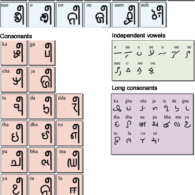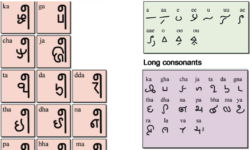Profile
Koya is one of nearly twenty scripts created by Dr. Prasanna Sree for indigenous and minority groups, mostly in Andhra Pradesh. In each case, the design of the script reflects some iconic feature of the culture of that linguistic community. She writes:Koya is a Dravidian language spoken by about 300,000 people in the Indian states of Andhra Pradesh and Odisha. The language is also known as Kavor, Kaya, Koa, Koi, Koi Gondi, Koitar, Koyato, Koyi and Raj Koya.
Koyas are found all along the Godavari river starting from Karimnagar in Telangana to East and West Godavari in Andhra Pradesh. The river Godavari has greatly influenced their socio-economic conditions: the land is extremely fertile, so it has also attracted the attention of non-tribal groups in large numbers who immigrated to the tribal areas and occupied their fertile lands. Most of the commercial crops like tobacco and chillies are cultivated by non-tribals.
The word koya means “hill-dweller.” The Koya tribe is divided into several occupational tribes such as blacksmiths, carpenters, brass workers and basket-makers. Their history is a long tale of suffering and oppression by the landlords and more recently by money-lenders and other new types of exploiters from the plains.
On the Hyderabad side of the Koya area, social workers have been active for some years in rehabilitating this tribe, but, on the whole, the economic distress of the Koyas is still most acute. During certain lean seasons of the year, food is so scarce that whole families, including children, live on tubers, tamarind seeds and palm juice.
The Koya claim their origin from the Pandavas of the epic Mahabharata, especially the lord Bhima. When the Pandava brothers were in exile, Bhima went hunting in the jungle and met a wild woman of the woods and subsequently got married. The fruit of the union was the Koya people. There are other legends connected with their origin.
The literacy rate among the Koya is extremely low and formal education is not favored. Usually boys study up to secondary level and girls continue only to primary level. They drop out because they have to work to support their families.
According to the great Indian epic the Mahabharatha, the strongest man in the world was Bhima. He married Hidimbhi, a tribal woman, and their son Ghatodhgaja was the founder of the Koya people. Bhima, his father, carried a mace, so the common graphic element in the Koya alphabet represents Bhima’s mace.
You can help support our research, education and advocacy work. Please consider making a donation today.


